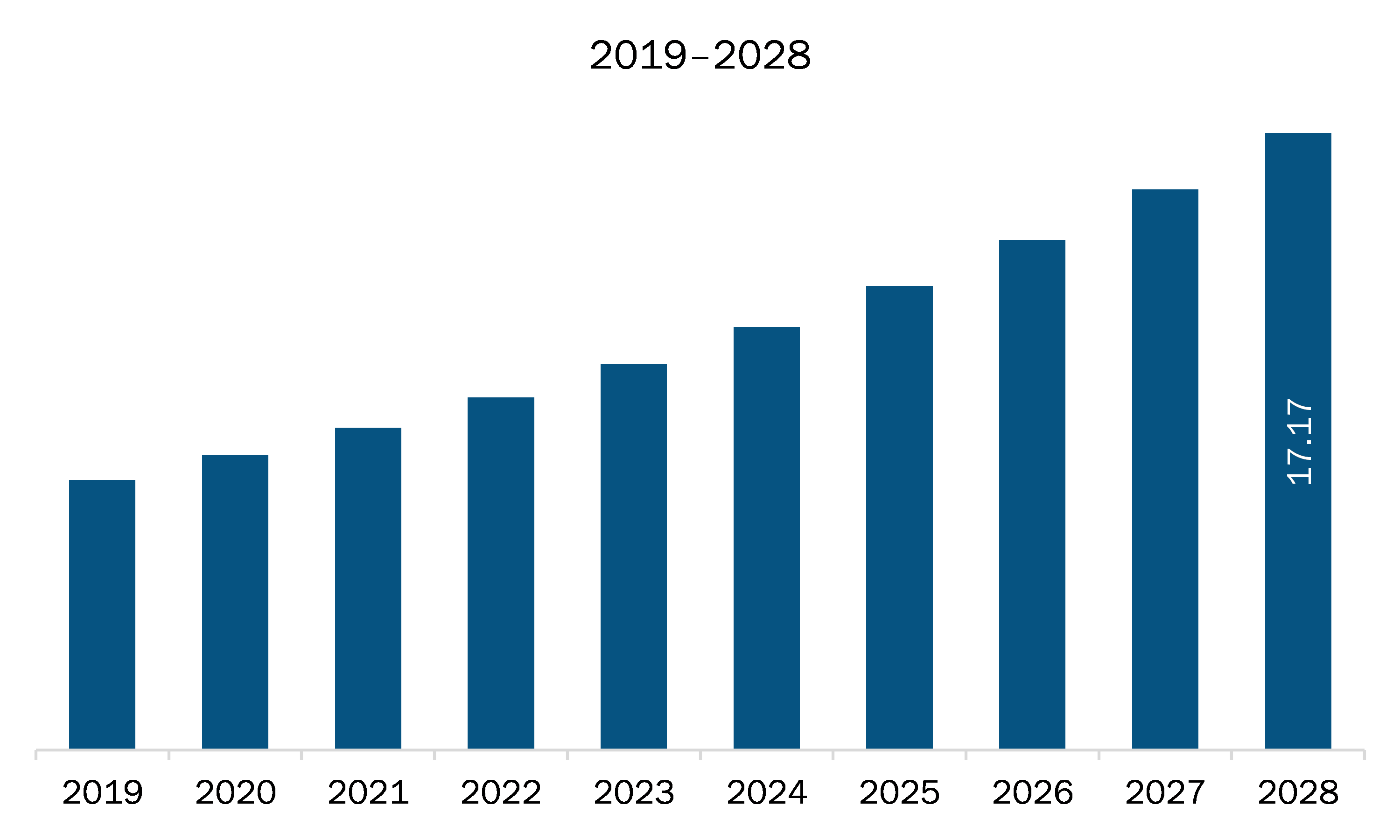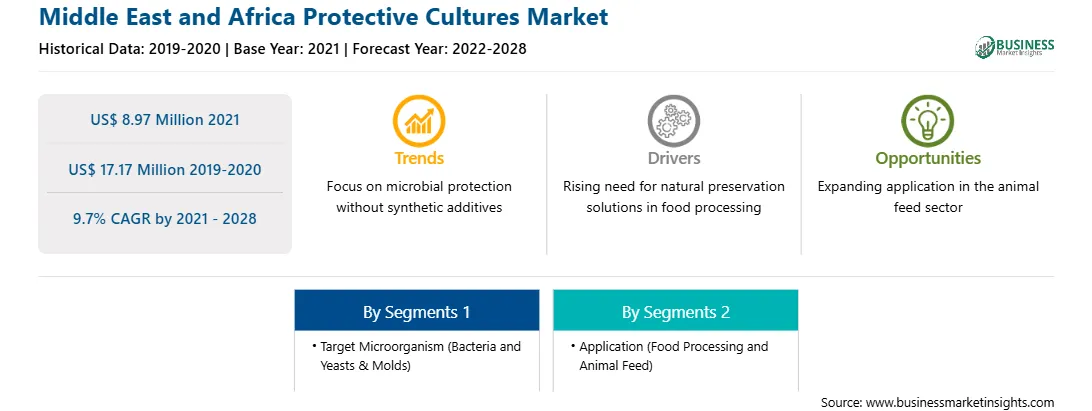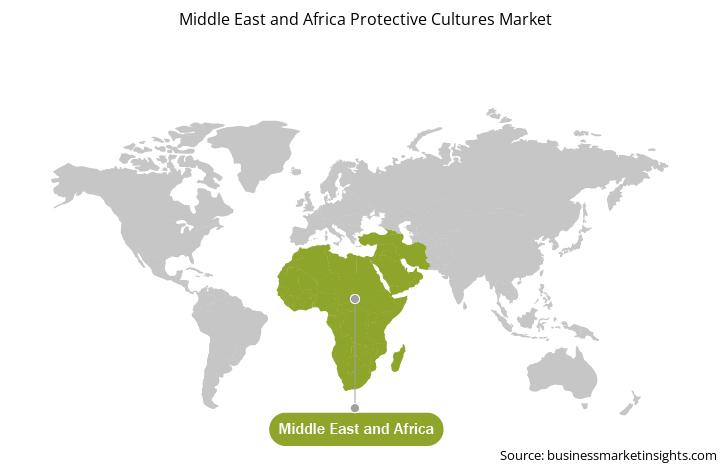The protective cultures market in Middle East & Africa is segmented into South Africa, Saudi Arabia, the UAE, and the rest of the Middle East and Africa. The region has witnessed a shift in socio-economic condition owing to the rapid economic developments, coupled with the rising disposable incomes of people. The increasing adoption of western culture, rising influence of western food habits on the young population, and hectic work schedules are a few factors propelling the demand for convenience food in the region. Therefore, manufacturers are incorporating protective cultures to inhibit the growth of pathogenic organisms or microbiological deterioration agents. The increasing utilization of protective cultures as natural preservatives in processed dairy products is primarily driving the growth of the protective cultures market in the region. Moreover, the Middle East & Africa is increasingly inclined toward using clean label ingredients and products. Protective cultures are natural and provide a valuable "green" advantage for food labels, which further promotes the growth of the protective cultures market. The consumers are looking for products with cleaner labels because they perceive them to be healthier, safer, and of higher quality. For instance, according to the food navigator, consumer's priorities for clean label products in Saudi Arabia are—a product should be a religion compliant diets, it does not have artificial additives or preservatives and pesticides or pollutants.
Turkey, South Africa, Iraq, and Israel have reported a high number of COVID-19 cases and deaths in the MEA. According to the International Finance Corporation, the COVID-19 pandemic has had a severe impact on the economy of the MEA, which led to decline in oil production and tourism, as well as remittances. Turkey has the highest number of COVID-19 cases in the MEA, followed by South Africa and the UAE, among others. Due to lockdown in the MEA countries, various food and beverages companies kept their facilities closed, which led to the reduction in the sale of various materials used in these industries, such as protective cultures.

Strategic insights for the Middle East and Africa Protective Cultures provides data-driven analysis of the industry landscape, including current trends, key players, and regional nuances. These insights offer actionable recommendations, enabling readers to differentiate themselves from competitors by identifying untapped segments or developing unique value propositions. Leveraging data analytics, these insights help industry players anticipate the market shifts, whether investors, manufacturers, or other stakeholders. A future-oriented perspective is essential, helping stakeholders anticipate market shifts and position themselves for long-term success in this dynamic region. Ultimately, effective strategic insights empower readers to make informed decisions that drive profitability and achieve their business objectives within the market.

| Report Attribute | Details |
|---|---|
| Market size in 2021 | US$ 8.97 Million |
| Market Size by 2028 | US$ 17.17 Million |
| Global CAGR (2021 - 2028) | 9.7% |
| Historical Data | 2019-2020 |
| Forecast period | 2022-2028 |
| Segments Covered |
By Target Microorganism
|
| Regions and Countries Covered | Middle East and Africa
|
| Market leaders and key company profiles |
The geographic scope of the Middle East and Africa Protective Cultures refers to the specific areas in which a business operates and competes. Understanding local distinctions, such as diverse consumer preferences (e.g., demand for specific plug types or battery backup durations), varying economic conditions, and regulatory environments, is crucial for tailoring strategies to specific markets. Businesses can expand their reach by identifying underserved areas or adapting their offerings to meet local demands. A clear market focus allows for more effective resource allocation, targeted marketing campaigns, and better positioning against local competitors, ultimately driving growth in those targeted areas.

The protective cultures market in MEA is expected to grow from US$ 8.97 million in 2021 to US$ 17.17 million by 2028; it is estimated to grow at a CAGR of 9.7% from 2021 to 2028. Emergence of animal feed as lucrative application; Animal feed products improve animals' health. Rapid urbanization and increasing consumption of meat and other end products, such as eggs and milk, across diverse regions stimulate the growth of the animal feed market. The animal feed helps enhance the animal's abilities by providing enriched nutrients and feedstuff, which accelerate growth and weight gain and strengthen immunity. Outbursts of diseases in animals are bolstering the adoption of animal feed as it heightens the animals' health and proper regulation of the food chain. Moreover, the high growth in the animal feed market is supported by the growth strategies of significant players in the form of investments and expansions, which helps them enhance the product portfolio and reach out to new target markets. Moreover, protective cultures have application in formulating clean label animal feed and pet foods. Animal feed manufacturers are focusing on evolving specialty cultures for animal feed. In recent years, silage producers in Europe have been using microbial strains to inhibit the growth of pathogenic micro-organisms in silage. For instance, DeLaval Inc. offers Feedtech Silage F3000, a bacterial culture that safeguards mold, clostridia, and yeast from developing and destroying the silage. Such rising initiatives by manufacturers for developing protective cultures for animal feed preservation are projected to create lucrative opportunities for the protective cultures market during the forecast period. This is bolstering the growth of the protective cultures market.
Based on target microorganism, the MEA protective cultures market is bifurcated into bacteria, and yeasts & molds. In 2020, the yeasts & molds segment held the largest share MEA protective cultures market. Based on application the market is divided into food processing and animal feed. The food processing segment accounts for largest market share in the 2020. Similarly, based on food processing, the market is bifurcated into dairy products
A few major primary and secondary sources referred to for preparing this report on the protective cultures market in MEA are company websites, annual reports, financial reports, national government documents, and statistical database, among others. Major companies listed in the report are Bioprox, Chr. Hansen Holding A/S, DSM, Lallemand Inc., International Flavors & Fragrances Inc., Kerry Group and Sacco System among others.
The Middle East and Africa Protective Cultures Market is valued at US$ 8.97 Million in 2021, it is projected to reach US$ 17.17 Million by 2028.
As per our report Middle East and Africa Protective Cultures Market, the market size is valued at US$ 8.97 Million in 2021, projecting it to reach US$ 17.17 Million by 2028. This translates to a CAGR of approximately 9.7% during the forecast period.
The Middle East and Africa Protective Cultures Market report typically cover these key segments-
The historic period, base year, and forecast period can vary slightly depending on the specific market research report. However, for the Middle East and Africa Protective Cultures Market report:
The Middle East and Africa Protective Cultures Market is populated by several key players, each contributing to its growth and innovation. Some of the major players include:
The Middle East and Africa Protective Cultures Market report is valuable for diverse stakeholders, including:
Essentially, anyone involved in or considering involvement in the Middle East and Africa Protective Cultures Market value chain can benefit from the information contained in a comprehensive market report.